The Midas Touch
Iris Scott’s Finger Paintings
New York-based (and Washington State-born) artist Iris Scott proves finger painting isn’t just child’s play. Her dynamic and colorful paintings command attention—and the art world has taken notice.
Why were you named Iris? Do you think it suits you?
In the Greek language, Iris means rainbow. She was the goddess of the rainbow. I’ve actually never taken the time to research my name until this very moment. I knew it meant rainbow, but I didn’t know it was the name of a Greek goddess. In light of my rainbow palette, I have to say my mom is excellent at naming.
What were your formative years like as an artist? What is your earliest art memory?
My formative years as a young artist began around first grade—I began dedicating noticeably more hours to practicing my drawing than to interacting with my peers. All I drew or seemed to care about were horses and unicorns, particularly if their manes were made of rainbows. [laughs]
When did you first consider yourself to be an artist?
I didn’t start calling myself an artist until 2010. I think that’s because I’ve always felt like such an amateur. When I finally started telling people I was an artist, it was after I had begun paying bills with my artwork.
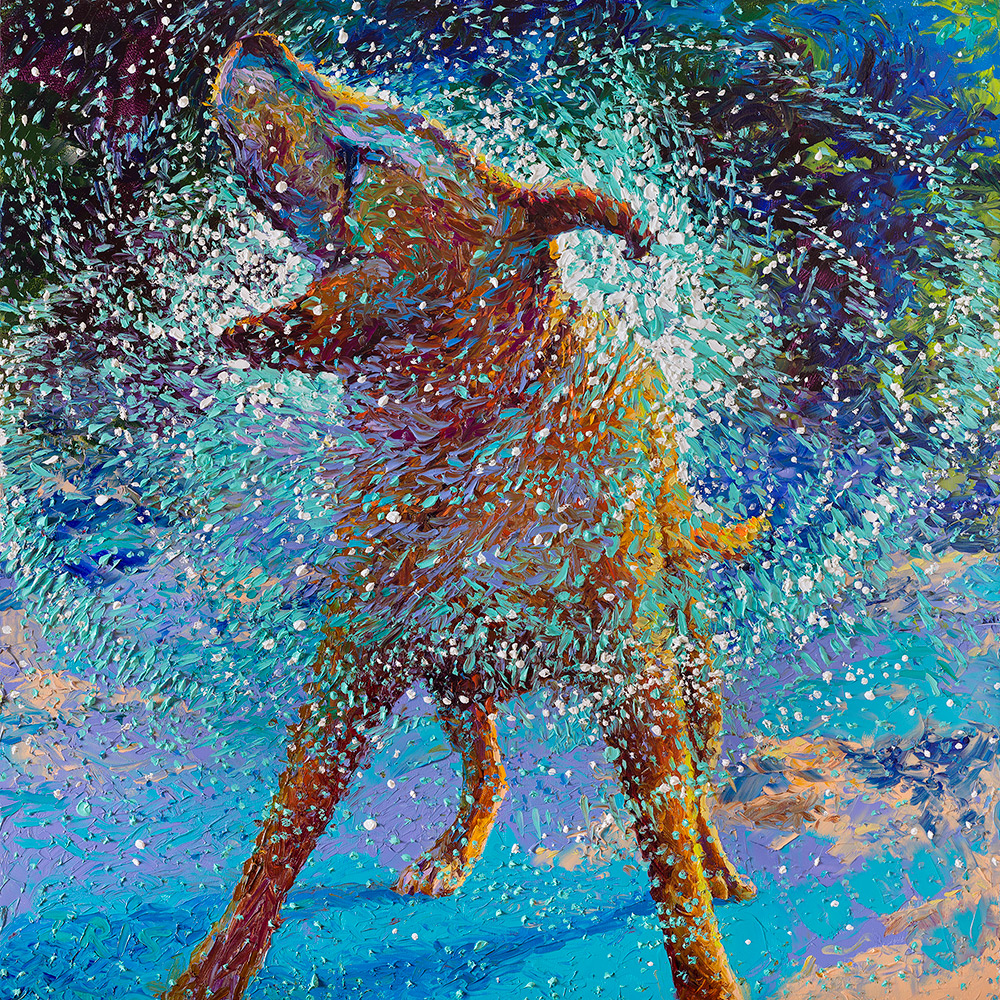 Swimmin' In Ice by Iris Scott.
Swimmin' In Ice by Iris Scott.
Did your parents support your artistic endeavors?
My parents have always been very supportive of my artistic pursuits. Neither of them ever told me it would be impossible to make a living from art. Both are artists in their own ways: my mother gives piano lessons and is a writer, and my father is a cabinetmaker. Being raised by two craftspeople helped shape my understanding of how skills are developed: you’re not usually born with them—it takes practice.
Can you give us a loose timeline of your painting style’s evolution?
As a ten-year-old, I self-taught watercolor techniques using books I checked out from the library. In high school, I began to paint with acrylics and felt like an adult because I was now painting on canvases. Throughout college, I was dedicated to learning realism. I drew and painted in as close to a photorealistic style as I could using oils. This was an invaluable step that cannot be skipped.
After college, I moved to Taiwan to live frugally and study art more in depth. There I focused on oil pastels (which are about the size and bluntness of a pinkie finger). Through this art medium, I began to let go of the need to paint fine details. This began a trajectory that would carry me even further away from realism. While I was painting with oils one day, my brushes were all dirty, and I didn’t want to pause to clean them. I finished a painting using my fingertips. I instantly knew this would be what I would spend my life pursuing. It was as if a bolt of lightning struck the top of my head—I saw a whole vision of my future turning oil finger painting into fine art.
"My parents have always been very supportive of my artistic pursuits. Neither of them ever told me it would be impossible to make a living from art."
Did you ever doubt if you were on the right career path? Did you ever do anything else?
Yes, I did doubt. Shortly after returning to my mom’s basement after a year living in Taiwan in 2010, money was running low. I had spent a lot in the transition from Asia back to the United States, and as my expenses shifted to an American cost of living, I panicked. Using my teacher certification I had earned while getting my master’s degree a year prior, I began sporadically substitute teaching at the local high school. Subbing was not my cup of tea, and it catapulted me back into my studio with a newfound vigor to get my painting gig off the ground. Shortly after, as my painting output doubled, sales did, too, and I was able to stop subbing. That was the last time I had anything resembling a traditional job.
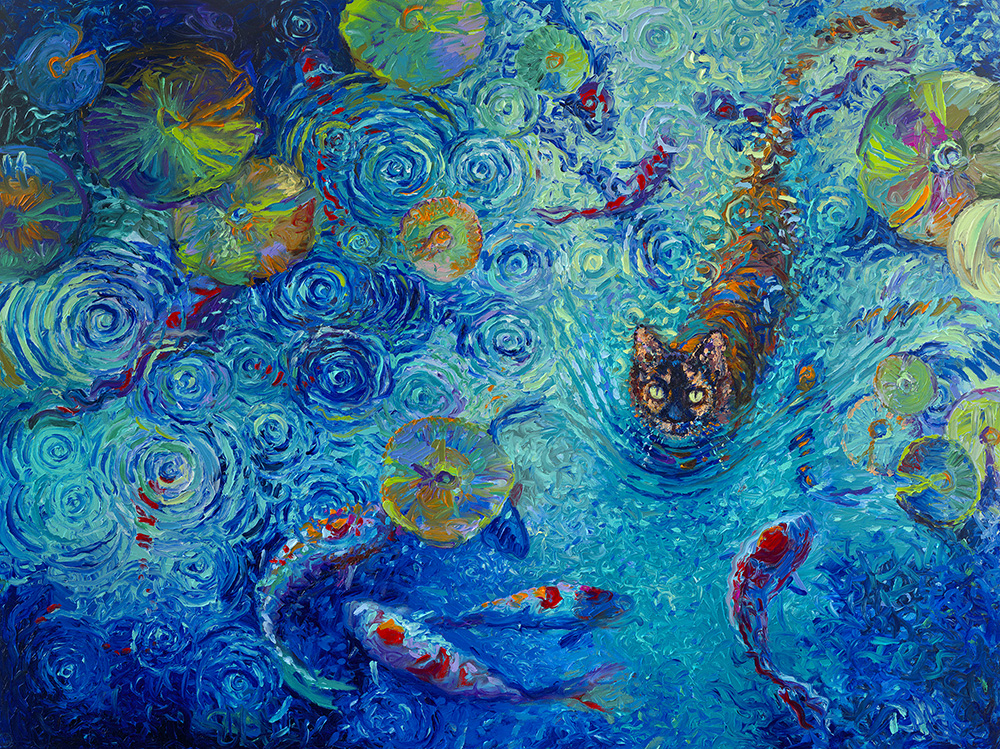 Coy by Iris Scott.
Coy by Iris Scott.
What is your state of mind while you are painting?
When I’m putting paint on canvas, it’s all problem solving and damage control. You would be surprised just how often I say to myself, “Yuck. That’s ugly. I need to get rid of that.” The real fun is imagining what to paint—the planning days that precede each painting. On painting days, especially toward the end of the day when the whole canvas is coming together and nearly finished, I’m thinking, “Hallelujah! I can’t believe I just pulled that off!”
Is your painting affected by what’s happening in the world or in your life?
It’s only beginning to. I’m only thirty-two, so I figure I have about seventy years of painting left to go. I’ve spent the last six years trying to learn the fundamentals of finger painting. Essentially, I’ve been in my own prerequisite classes. I’m really looking forward to transitioning my skill at creating visually stimulating work to creating content-saturated masterpieces in the future. I think one of the flaws of art education at the university level in America is that students are pressured to be so conceptual way too early in their development. It’s a classic cart-before-the-horse scenario that leads to a tremendous amount of conceptual art that nobody has any interest in.
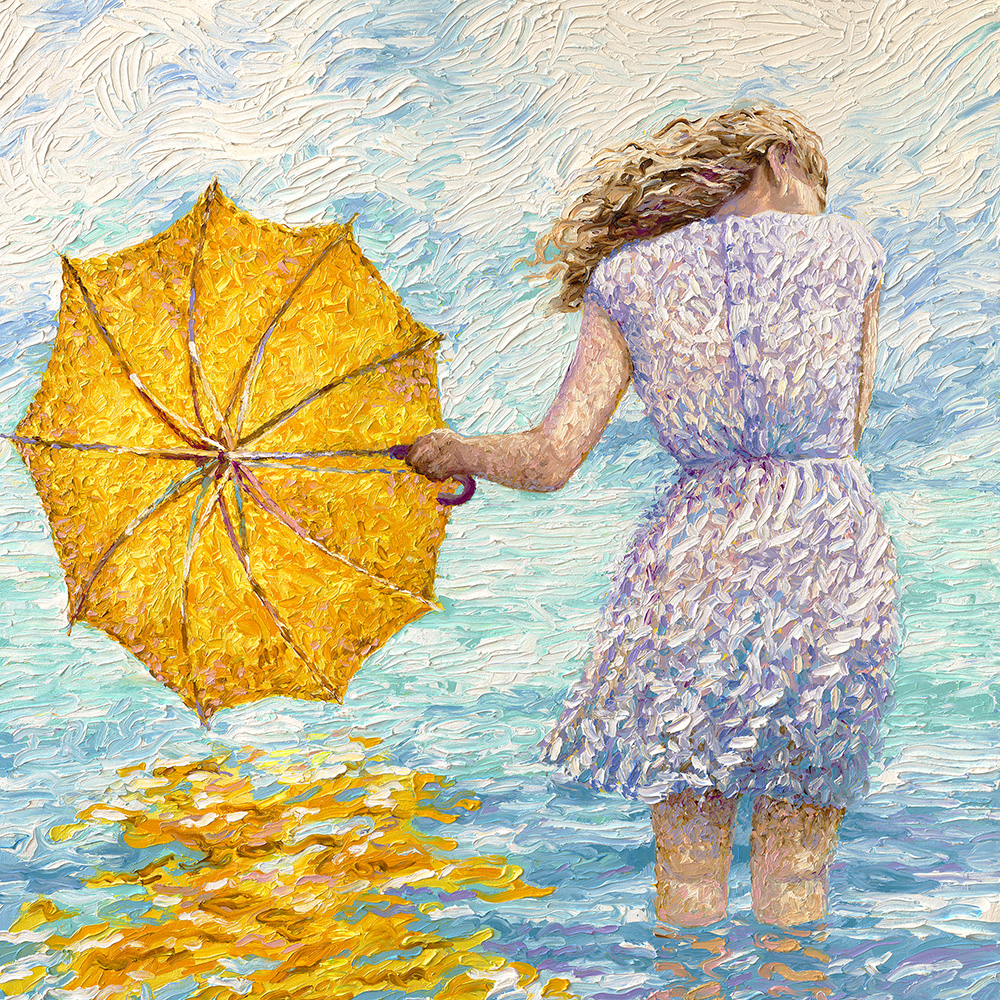 Georgia's Sister by Iris Scott.
Georgia's Sister by Iris Scott.
Do you conceptualize your work first, or do you just start painting and see what emerges?
Nearly every painting begins first with a detailed sketch complete with color planning. Sometimes, in the case of easier topics like fish or flowers, the scene can grow organically and doesn’t require as much planning.
There is an incredible amount of energy and movement in your paintings. Do you attribute this to finger painting?
Yes! I have multiple points of contact all working together chaotically.
Is it important for you to be different than other artists?
Yes. But like Picasso has been quoted as saying, “Great artists steal!” The important thing is to be a total sponge for all the effects you’re drawn to. As long as you cover up your tracks, it’s OK. If the public can’t really tell you’re copying a few artists and melding them together, it’s because you’re creating a hybrid. Hybrids are legitimate and what art is all about. Go for it! Copy masters when you’re a beginner and pretty soon you’ll know how to solve your own painting problems.
"I’m really looking forward to transitioning my skill at creating visually stimulating work to creating content-saturated masterpieces in the future."
Do you put dollops on a palette? What is your preferred brand of paint?
I don’t use a palette. Instead, I leave all the one hundred-plus tubes of colors open at all times, grab them when I need them, and squeeze out paint directly onto my fingertips. It’s a highly efficient process. Hands down, my favorite paints are Holbein DUO Aqua Oils.
Do you paint from memory, or do you use reference photographs?
Both, although most is from reference photography. Don’t ever let anyone put you down for utilizing photographs. Many famous artists I know in New York use photographs. If Da Vinci or Van Gogh would have had access to these tools, they would have most certainly used them.
Where do you currently reside? What makes you stay? How does it influence your artistic style?
I live in a 1,200-square-foot artist’s loft that consists of one big room in an old mattress factory in the center of Brooklyn. I’m surrounded by a concrete jungle. The lack of plants and animals makes me obsessed with painting nature.
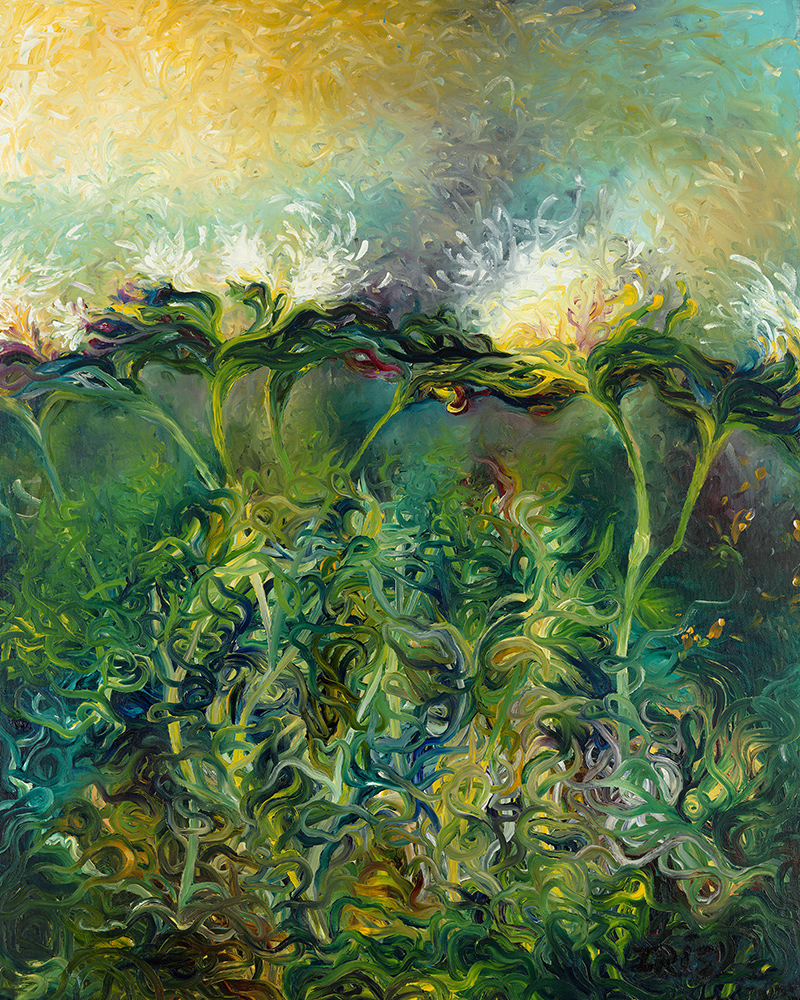 Artichoke Bloom by Iris Scott.
Artichoke Bloom by Iris Scott.
Can you explain the art movement happening in Brooklyn right now called instinctualism?
Instinctualism is a sort of renaissance emerging in New York. From the fourteenth through seventeenth centuries, starting in Italy, a revival of ancient Greek art occurred because artists had grown so sick of what was in fashion at the time: Gothic. In a similar way, instinctualism is a reaction to the minimalistic art movement that still dominates the art world. After 1945, art took a sharp turn and led to what we know as contemporary art. By contrast, instinctualism aims to build upon what the postimpressionists were developing in the early 1900s before 1945 hit. It’s classical beauty that often fixates on the natural world.
After 1945, when the Industrial Age led to mass-produced things, there was a sharp decline in artisans and a steep increase in advertising. Instinctualist painting is about craftsmanship, apprenticeship, and classically beautiful things. It’s an aesthetic that doesn’t require lengthy artists’ statements, and it transcends tastes manufactured by advertising. Children and people from all backgrounds are drawn to it because it touches on a visual instinct we’ve inherited from our ancestors. It appeals to the masses rather than alienating them.
 The Discussion by Iris Scott.
The Discussion by Iris Scott.
What’s the best criticism you received? What was the hardest to swallow? Do you thrive more through praise or criticism?
I frequently encourage my friends to tell me like it is. I beg them to be honest with me. I listen for echoes. If out of five of my friends, only one of them thinks I shouldn’t put the bird in front of the jaguar, then I likely won’t listen. But if all five of them are antibird, I’m quite likely to listen. My own ego is my worst enemy, and I’ve found that whenever I can overcome it, I make much stronger art.
How long does it take to complete one painting?
It’s taken me twenty-five years of practicing drawing, six years of trial-and-error finger painting, and four hundred completed canvases to figure out how to start and finish a medium-sized (36 x 48) finger painting in one day.
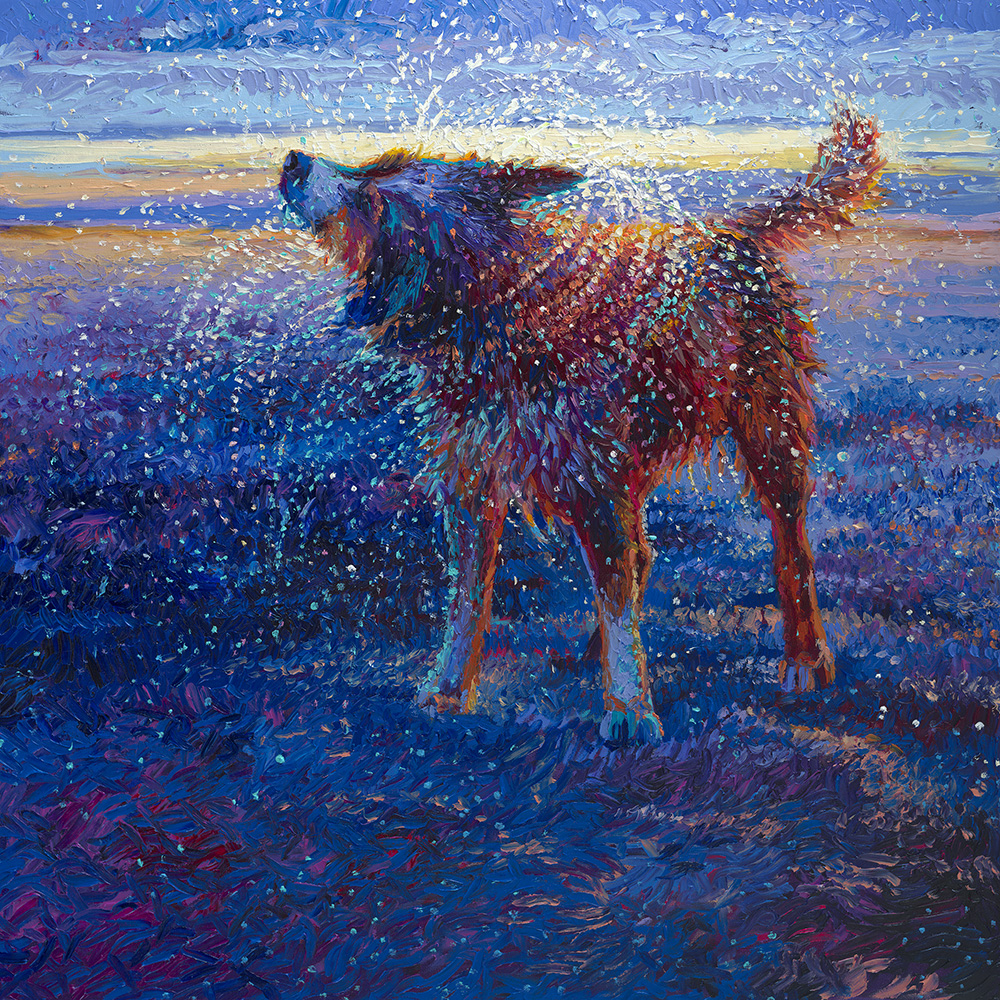 Coastal Canine by Iris Scott.
Coastal Canine by Iris Scott.
Is your work based on commission, or do you only paint what you feel?
About 10 percent is commissioned; the remainder is what I feel like painting, which I then ship out to the other galleries.
What do you hope an audience will perceive when looking at your paintings?
Abundance. I’m so tired of looking at the art of overly serious artists who are so fixated on what is wrong with the world. It’s time we start focusing our mental energy on what is wonderful, healthy, natural, joyous, and kind in the world so we can manifest more of it. You wouldn’t know it by listening to the news, but breakthroughs are happening left and right. We are actually far better off worldwide than we’ve ever been.
"Children and people from all backgrounds are drawn to [instinctualism] because it touches on a visual instinct we’ve inherited from our ancestors. It appeals to the masses rather than alienating them."
What inspires you?
I’m inspired by virtually each and every piece of art I can find in museums, from ancient Egypt to Picasso. I love it all.
What are your favorite cities?
Rome blew my mind when I spent three days there in 2004. Rajasthan in India changed my life, and Kaohsiung (in Taiwan) will always hold a special place in my heart because I found finger painting there.
What is the atmosphere of your studio where you paint? Is there music playing? What is the vibe?
It’s a live/work space. My studio has a calico cat named Foxy. My bed is a Murphy bed. The easel is in the corner, and it’s all very clean and tidy. There’s a stack of fifty canvases on the south wall. The vibe is a lot of white, wood, and indoor plants. Music is always playing, and the cars outside keep it from ever being silent.
 Photo courtesy of David Mackey.
Photo courtesy of David Mackey.
How do you fight creative block?
I leave the house for a day, or I take a trip, and within forty-eight hours I’m dying to be home working on a painting.
What career are you neglecting right now by being a painter?
Movie director/screenwriter. This was the other passion I had as a child—my parents let me shoot short films with the camcorder, and I loved it!
Where are you when you’re not painting?
Painting is a very lonesome career—no colleagues, no boss. There’s nobody really to talk with because I’m flying solo. So when I’m not painting, I’m actively planning social escapes. Luckily for me, in Brooklyn that’s never far away. Find me a rooftop party, and I’m there!
For more info, visit irisscottfineart.com.





Posted in Feature, Issue 83 Vol 1 on Mar 08, 2017